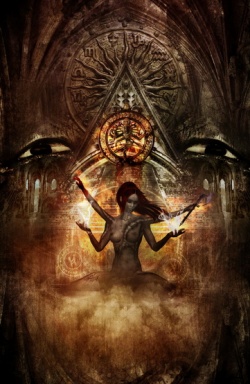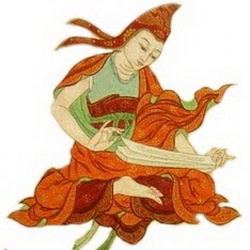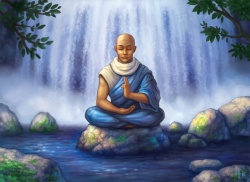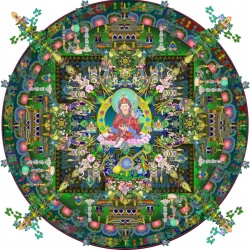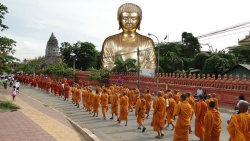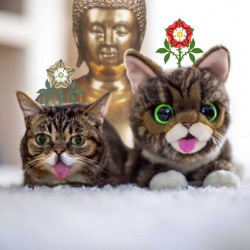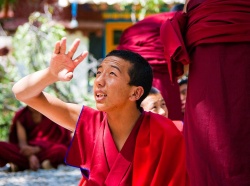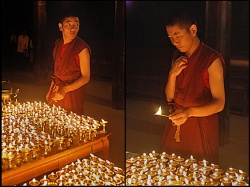What are Gods & Deities in Tantric Buddhist Art?
Gods & Deities are a common feature of Tantric Buddhism.
What are they exactly?
Who are they and where do they come from?
This is a big question in Tibetan Buddhism and subsequently it is important to understand. Deities make up a large percentage of the iconography in painting, sculpture and more importantly meditation practice.
Initially the most important point to learn is that the two English terms 'god' and 'deity' are commonly used interchangeably, both colloquially and in academic circles, with no real intended difference in meaning.
What exactly are Gods & Deities? There is probably no easy way to answer this question. The most direct route requires dividing the question into two topics.
The first topic is a generally broad but inclusive definition of the word god/deity (Tibetan: lha, yi dam) based on a general Tibetan understanding and a conservative dose of Western interpretation.
The Tibetan word 'lha' meaning god is more generally used for all types of gods. The word 'yi dam' is intended for a special type of deity unique to Tantric Buddhism.
The second topic is the enumeration of categories and the many traditional lists and sub-categories of deities that are referred to in Indian and Tibetan Buddhist texts and traditions.
The Tantric Buddhist definition for 'deities/gods' distinguishes between two very important and different types. The first type is Worldly Gods and the second type is Beyond-worldly Gods.
Ordinarily most people refer to all deities as gods and gods as deities and don't distinguish between worldly and beyond-worldly.
In general a god is a supernatural being or presence that lives outside of our normal daily reality that has the power to interact, for good or ill, in our personal reality through a spiritual connection, ritual, or cause and effect relationship.
Within Buddhism these Worldly Gods are understood as sentient beings that have powers and life circumstances that are different than that of normal humans but occupy and move through the Wheel of Existence - Samsara - just as humans do based on the laws of cause and effect.
Examples of Worldly Gods (lha) are Brahma, Indra, Vishnu, Shiva, along with all of the other less familiar Hindu characters. Included amongst those are the Guardians of the Four Directions, the local gods of the various Buddhist regions, Nepal, Tibet, Bhutan, inclusive of the many mountain and regional gods.
At the side is an example of the Worldly God Brahma, with four faces, orange, and riding a large goose.
In Tantric Buddhism these worldly gods of Indian origin are commonly found in the outer retinues of many mandala deities such as medicine Buddha, Sitatapatra, Eleven-faced Avalokiteshvara and others.
In the Anuttarayoga Tantras the four principal Indian gods are often trampled under the feet of wrathful and semi-wrathful meditational deities such as Hevajra, Chakrasamvara, Vajrakila and others.
Principal Worldly Gods:
- - Brahma, yellow, holding a wheel, riding a goose.
- - Indra, white, holding a vajra, riding an elephant.
- - Agni, red, holding a fire pot, riding a goat.
- - Yama, blue, holding a stick, riding a buffalo.
- - Raksha, black-maroon, holding a sword, riding a zombie.
- - Varuna, white, holding a snake lasso, riding a makara.
- - Vayu Deva, smoky-coloured, holding a banner, riding a deer.
- - Yaksha, yellow, holding a mongoose, riding a horse.
- - Ishana, white, holding a trident, riding a buffalo.
- - Bhudevi, yellow, holding a vase, riding a sow.
Other gods and goddesses of note originating in India are Shiva, Durga, Kali, and all of the other female figures such as Lakshmi, Sarasvati and Parvati.
The majority of Tibetan worldly gods have been incorporated into the pantheon as protectors. Most originate as mountain or regional gods. An even lower classification is that of spirits and demons.
The Beyond-worldly Gods (Wisdom Deities, Tibetan: yi dam) are believed to be unique to Buddhism and live outside of the Wheel of Existence.
They are considered enlightened individuals or emanations of enlightened individuals.
The Beyond Worldly type are divided into two further categories, [1] Individual Entities and those that are [2] Emanations.
Examples of well known Individual Entities that have escaped from Samsara are Shakyamuni Buddha, Medicine Buddha and the meditational deity forms of Manjushri, Avalokiteshvara, Vajrapani and Tara.
Emanations originate generally from the Five Symbolic Buddhas (Vairochana, Amitabha, Akshobhya, Ratnasambhava and Amoghasiddhi) or from the Tantric meditational forms of Manjushri, Avalokiteshvara and Vajrapani.
Examples of Emanations are figures such as Hevajra, Chakrasamvara, Vajrayogini, Kalachakra, Mahakala along with many others.
The lists and sub-categories of deities can be long and sometimes over-lap. Next week we will look at some of the more common and well-known categories of Buddhist Tantric Deities such as Long-life, Power, and Deities of Protection.
Deities According to the Three Traditional Descriptive Categories (Three Moods):
- (1) Peaceful
- (2) Semi-peaceful/semi-wrathful
- (3) Wrathful Deities According to the Four Tantric Buddhist Activities:
- (1) Peaceful Activities
- (2) Increasing Activities
- (3) Powerful Activities
- (4) Wrathful Activities
The Traditional Categories of Deities According to Function:
- (1) Buddha
- (2) Meditational Deity:
- (3) Long-life
- (4) Wisdom
- (5) Power
- (6) Miscellaneous
- (7) Protectors:
- (8) Protector, Worldly:
- (9) Wealth Deity
- (10) Purification
Deities According to the Four Classes of Buddhist Tantra :
- (1) Kriya Tantra
- (2) Charya Tantra
- (3) Yoga Tantra
- (4) Anuttarayoga Tantra
Jeff Watt 5-2012
